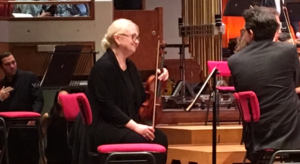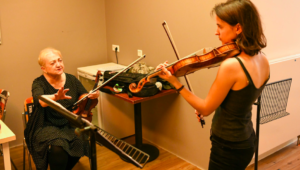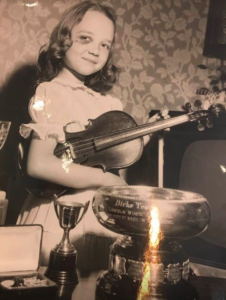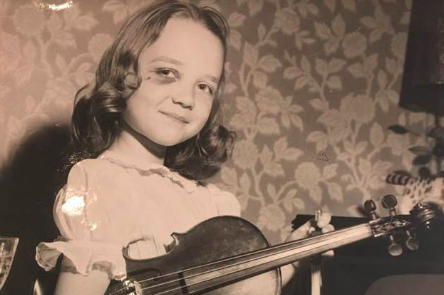There is a picture of five year old Elaine Klimasko that seems to sum her up perfectly.
She’s sitting rather formally in her best dress with a slight smile on her face, holding her violin, surrounded by trophies and sporting a pretty serious black eye. She had been accidentally kicked by a kid climbing a set of monkey bars in a playground.
Battle-scarred, she carried on with some determination and no little courage.
It’s the kind of drive that has carried Klimasko through 50 years in the violin section of the NAC Orchestra. And there’s no indication she’s stopping anytime soon, having recently signed a contract for her 51st season.
Not only is she playing all the concerts this season, she is on NACO’s current tour of Europe including London, Paris, Utrecht, Copenhagen Stockholm and Gothenburg, Sweden. It’s a blistering pace and Elaine is working hard to keep up. But she is keeping up, playing concerts and giving masterclasses.

Getting ready for a concert on the NACO 50th anniversary tour. Photo: Peter Robb
And when she gets back, she’ll perform in the June 2 concert that will mark the 50th anniversary of the opening of the NAC in 1969. And she’ll return to another passion, teaching young musicians how to play.
It’s a good thing her husband Ed doesn’t mind doing things around the house, she says, because Elaine is a going musical concern.
She was there all those decades ago but not in NACO. It had yet to debut. She was in the orchestra pit in Southam Hall with the National Ballet of Canada which was in Ottawa that night to christen the centre.
Getting to that momentous evening is kind of a typical musician’s story.
Elaine comes from a large family in Hamilton. She’s the third child of seven. Her father was prominent dental specialist in the city; her mother was the musical one.
“My mother came from small town Saskatchewan. Her father bought her a violin at age five or six from the Eaton’s catalogue. It cost $4.95. She taught herself to fiddle and became the top fiddler in barn dances in Goodeve, Sask.,” she said.

NACO in 1969. Photo: Fred Cattroll

Elaine Klimasko, top left, when she joined to NAC Orchestra in 1969. Photo: Fred Cattroll
So music was in the house. Her older sisters both played violin and when Elaine was about three she started on it too. (It’s continuing for another generation as her son Michael Blais is a cellist and a music teacher.)
“It was a blessing in disguise to have two older sisters. I heard all those pieces they were playing. If you have any talent, and, hopefully, I did, it just gets into your brain early.”
She has fond early memories of asking her mother to turn on recordings of classical music.
“I just remember the overwhelming joy I felt when I heard a full symphony play. I would dance around the living room. She said none of the other kids did that.”
That joy explains a lot.
“I think I am the luckiest person alive. I can play Brahms Symphony and feel as refreshed about it and as special about it as the first time I played it.
“I don’t think everybody can say that. We all honour and respect the music but the joy in playing and the performance of it has never left me. That’s why I haven’t retired.”
Now that doesn’t mean she doesn’t get tired, she does. But she soldiers on.

Working with a young Dutch violinist in Utrecht, The Netherlands. Photo: Fred Cattroll
She is battling through a case of dystonia, a condition that has ended many musical careers. In Elaine’s case the dystonia manifests in two ways: one causes her eyes to blink an abnormal amount. The other pushes her chin down towards her neck.
The conditions started to develop in 2000. The NAC’s former music director Pinchas Zukerman helped her immensely by introducing her to the doctor in New York who treats her still.
She gets meds to control her chin. Her blinking eyelids are treated with Botox injections in the area of the eye. It started with 12 shots and it’s now down to four.
That determination starts more than 50 years ago when four Klimasko girls would get in the family car at the crack of dawn every Saturday and head down the QEW to the Royal Conservatory in Toronto for lessons.
Elaine, who started doing this weekly drive at age eight, was studying with a “magnificent man” named John Moskalyk. She took lessons, played chamber music and played in an orchestra.
“That was my Saturdays. I could never go to my girlfriends’ birthday parties.”
Another teacher named Ethel Norris was the one who detected that Elaine had perfect pitch.
“It is an advantage. You hear all the notes beforehand. I don’t understand how people manage without it.”
She studied with Moskalyk until 14 when he died suddenly of a heart attack.
She had to find a new teacher and was put in touch with Lorand Fenyves. After a few years, he said to her “‘I want you to audition for something’.
“So I flew to Montreal and performed in front of 10-15 men in dark suits and stern faces … no nerves whatsoever. I was very sure of myself in those days. I thought there was nothing to be afraid of.
“It went well. After that, I put a knapsack on my back a few days after that and went to discover Europe on my own.”
While she was in Europe her parents sent her a telegram saying “I had been accepted into the National Arts Centre Orchestra.”
She came home, moved to Ottawa “and here I am 50 years later.”
Elaine was “so very young, just 19. To this day I remain the youngest ever to join the orchestra.”
She was so young, she said, that “everything was new to me. I hadn’t heard of many of the pieces, let alone having played them.”
Because she got an orchestra job out of high school, she didn’t go to university save for a sabbatical year when she was 29 studying with the great Josef Gingold at Indiana University.
“That was one of the best and most important years of my life. Mr. Gingold was an amazing teacher and the who’s who of the music world was there.”
The early years with NACO were busy. Elaine was playing concerts with NACO and gigging all over town. She played with Thirteen Strings Orchestra and subbed in for shows with stars like Rich Little and The Carpenters when they came to the Ottawa Ex.
“You were just running from location to location to do whatever. I love doing things like that.”
Summers were full too at the NAC with the annual opera festival started by Mario Bernardi.
“I miss that opera festival dearly. It was really a special time. The who’s who of the opera world were here performing; Louis Quilico and Marilyn Horne. It was phenomenal what we did.”
She remembers the yachts floating outside. A member of NACO had a boat and the gang would gather after a show and glide down the Rideau Canal.
NACO made its debut on On Oct. 7, 1969.

Surrounded by her winnings, including a black eye.
Jean-Marie Beaudet was NACO’s first music director but he died soon after. He was followed into the job by Mario Bernardi who shepherded NACO until 1982.
Bernardi was “very good to me, very nurturing, very encouraging, He was a tough conductor. He was demanding and he could be impatient. Our friendship continued after he left. He never made me feel I wasn’t deserving of being part of the orchestra.”
But there was a side to Bernardi that would not be tolerated today.
“I remember once asking for a raise because everyone else was asking one. I thought I might as well too. I went in and the response to me was, ‘Well, why do you need more money. you don’t have to support a family like a man’.”
It was a different time, she said. “You do that now and you could” be in a lot of trouble.
Another thing Elaine misses from those early years is NACO’s chamber music program.
“In those days, we had a chamber series. It was saddest thing to lose that.” Not just because the opportunity to play chamber music inside NACO was lost but also because the series brought in talented coaches for the orchestra members.
“I played with William Primrose, probably the greatest violist of the 20th century,” for example.
She believes the chamber series and opera made the members of the orchestra better musicians.
“No other orchestra that I know of had such a program. It was a huge calling card.”
After Bernardi left in 1982, the orchestra faced a bit of a revolving door of maestros. Franco Mannino (1982–1987) was followed by Gabriel Chmura (1987–1990) and then Trevor Pinnock (1991–1997).
“I took away something from every one of the music directors and conductors,” she said.

Outside La Seine Musicale in Paris, France where NACO would play May 17 and 18.
Meanwhile there were other problems in the NAC caused by funding shortfalls and bad management.
“I would say it was because we had Yvon DesRochers there as director. It was a nightmare. He was as approachable as a rattlesnake. That is the darkest period that I remember.”
DesRochers was no Hamilton Southam, the NAC’s first director general, she said. “He (Southam) treated us like we were all very special people.”
Then things turned around. The centre hired Pinchas Zukerman as music director and the world famous violinist, after a battle, reshaped the orchestra. For Klimasko, it was all good.
“I am a huge Pinchas fan as you probably know. He is god for me. it just doesn’t get better. When we performed the Beethoven Violin Concerto in Leipzig, Germany, I still can’t talk about that performance without getting teary-eyed, it was so profound.
“There were two young men sitting in the front row and they were being very surreptitious about it but they had their scores with them and they were obviously violinists and huge Pinchas fans. They were just weeping from what he could do with his instrument.
“He is greatest violinist who ever lived in my opinion.”
He was important, not only for helping her with her dystonia, but also “ I could knock on his door any time of the day and ask advice about what to do wth a student.”
As far as the current music director, Klimasko cannot get over Alexander Shelley’s ability to relate to an audience and his passion for music education; something she cares about as well.
“I am the artistic director of the Ottawa Suzuki Strings. My sister founded this incredible school and got sick and I couldn’t bear to pass it to someone who wasn’t going to put their heart and soul into it.
“So I took over. It’s a lot of work, no pay and isn’t always fun, but that’s OK. I asked Alexander if he would visit the school and he’s come twice. He’s amazing about that.”
She says she would like to continue teaching for as long as she can. “I hope I can put in another 10-15 years of teaching because I’m a good teacher now. I know a lot because I’m old.”
That drive to teach has taken her as far afield as Argentina, but that’s not why she went to the South American country initially.
“That started because I was concerned about my violin. Once I leave the orchestra I won’t be able to afford the insurance on it. It’s now extremely valuable.”
Her father bought her an 1831 Pressenda half a century ago and she’s been playing it ever since. The other player in NACO who has one is Yosuke Kawasaki, the concertmaster.
“Those two violins hung on a wall side by side. Now some 200 years down the road they are being played in the same orchestra. It’s cool to think about.”
She went to Argentina to buy a violin from a maker there named Daniel Karinkanta. Once she leaves NACO, she will sell her Pressenda and carry on with her Karinkanta.
She’ll miss the Pressenda, “but it’s time to pass it on to some other younger violinist who will enjoy it and be partners with it.”
While she is continuing the memories of a life in music are starting to pile up. She has worked with many great conductors over the years including NACO’s former principal guest maestro Franz-Paul Decker (“That was a conductor, a real conductor”).
“I have worked with everybody, even Gustavo Dudamel. I worked with Zubin Mehta once.” And Bernardi got Vladimir Ashkenazi to come, she said.
She has literally been around the world on orchestra tours to from Japan, China, all over Europe and the United States. She remembers playing in Leningrad (now St. Petersburg) in 1973 in front of Prokofiev’s widow.
“I’ve been across Canada a million times and slept in motels in every small town. I remember those tours fondly because the people were so appreciative that we came and played for them.
“It was fun and they’d make the best egg salad sandwiches in the world.”







